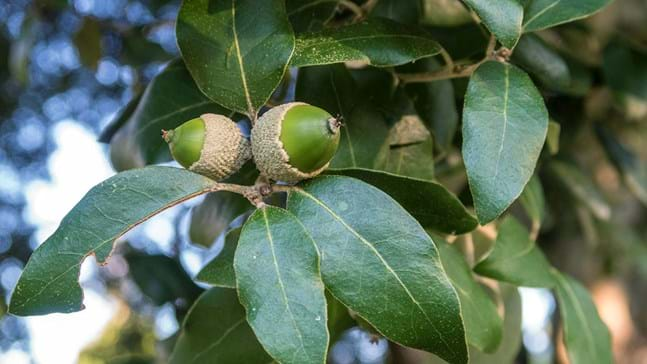
Credit: Nature Photographers Ltd / WTML
Leaves
Oval, dark green to black and concave with a coating of pale hairs on the underside. Young leaves are spiny, like holly leaves, whereas older leaves have smooth edges.
With its evergreen leaves, the holm oak is a bold splash of colour in the winter months. It was first introduced in the 1500s and, though it’s not as adapted as our native oaks, it supports plenty of our wildlife.
Common names: holm oak, holly oak
Scientific name: Quercus ilex
Family: Fagaceae
Origin: non-native
Holm oak is an evergreen broadleaf tree that can grow to 20m and develop a huge, rounded crown. It was introduced to Britain in the late 1500s. The bark is black and finely cracked, and twigs are slender and covered with light brown felt-like hairs.
Look out for: the leaves which are glossy above and downy below, without lobes. Young leaves can be toothed.
Identified in winter by: its evergreen features which are present all year round.

Credit: Nature Photographers Ltd / WTML
Oval, dark green to black and concave with a coating of pale hairs on the underside. Young leaves are spiny, like holly leaves, whereas older leaves have smooth edges.

Credit: Nature Photographers Ltd / WTML
Small, elongated yellow catkins with both male and female flowers hanging off the tree.

Credit: Photo Central / Alamy Stock Photo
After pollination by wind, female flowers develop into acorns, which are smaller and have a more pointed tip than those of English or sessile oaks. Young acorns are green and mature to a dark red-brown before falling.

Download our free Tree ID app for Android and iPhone to identify the UK's native and non-native trees. It's an A-Z tree guide in your pocket.
Download the appHolm oak is a native to the Eastern Mediterranean but has been naturalised in the UK. It lends itself well to shaping and is found in parks and gardens.
Trees are resistant to salt-spray from the sea, and are often planted as a windbreak in coastal areas. However, they can’t stand freezing conditions and during severe winters they are prone to dying or losing their leaves, so are more common in the south of the UK.

Credit: Phil Winter / WTML
Holm oak is not as valuable to wildlife as native English and sessile oaks, but its catkins provide a source of pollen for bees and other insects, and its dense, evergreen canopy offers year-round shelter for birds.
In ancient Greece, the leaves of the holm oak were used to tell the future and they were also used to make crowns to honour people. The acorn was also a symbol of fertility and was worn on jewellery to increase chances of conception.
Holm oak timber is incredibly hard and strong. The Romans used the wood for making the wheels of carts and carriages, as well as for agricultural tools. Today it is sometimes used for firewood as it is slow and long lasting. Holm oak acorns are fed to pigs reared for Ibérico ham.
In addition to being planted as windbreaks along the sea coast because of their resistance to salt-spray, their ability to tolerate shade and air pollution makes them ideal as street trees and for planting in city parks.
Holm oak is less susceptible to pests and pathogens than our native English and sessile oaks, although it may be susceptible to acute oak decline and chronic oak decline.

Shop
We have single trees and tree packs to meet your needs, from wildlife to woodfuel. Delivery is free.
External link

Take part in our Nature's Calendar survey
Tell us what's happening to the trees around you and help scientists track the effects of climate change on wildlife.
External link